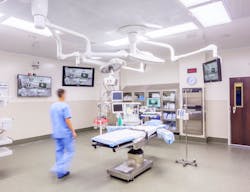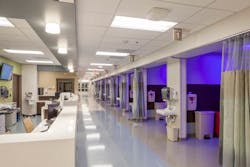Analyzing Germicidal Lighting Options
Safety guidelines from federal, state and local authorities are rapidly changing in response to the highly transmissible COVID-19 Delta variant. Facilities are updating their policies and are looking for resources to help keep buildings open and occupants safe. Though no one solution works for all places, public spaces need to focus on proper ventilation, air filtration, air quality monitoring and germicidal lighting.
According to data presented in a May 2021 post at www.sciencenews.org, COVID-19 is mainly spread through the aerosolization of particles that can hang in the air for hours.
Learning how to clean the air of potentially virus-laden aerosols can have long-term benefits for health and allow businesses and schools to remain open during future outbreaks. Knocking respiratory viruses out of circulation wouldn’t just improve health, it will also be good for the bottom line. In the United States alone, yearly economic losses from flu total $11.2 billion, and other respiratory viruses cost about $40 billion. COVID-19’s global monthly harm is estimated to be $1 trillion, according to that www.sciencenews.org post.
GERMICIDAL LIGHTING & HEALTHCARE FACILITIES
The healthcare industry has grappled with this issue for years due to Hospital Acquired Infections (HAIs), which have been a catalyst for medical facilities adopting germicidal lighting to kill pathogens. A direct approach to prevent the transmission of airborne-mediated disease is inactivation of the corresponding airborne pathogens. In fact, the airborne antimicrobial efficacy of germicidal light has long been established and can also efficiently inactivate both drug-sensitive and multi-drug-resistant bacteria, as well as differing strains of viruses, according to a post at www.nature.com. But not all germicidal lighting is safe for humans, and knowing the differences will help you provide the lighting products that meet the design specifications your contractor customers will follow in the lighting systems they install in these facilities.
405 nanometer (nm) visible light disinfection. Evidence demonstrating the persistent contamination of environmental surfaces despite traditional cleaning and disinfection methods has led to the widespread acceptance that there is both a need for reassessing traditional cleaning protocols and for using secondary disinfection technologies, according to a Jan. 2017 post in a newsletter published by the Coalition for Healthcare Acquired Infection Reduction (CHAIR).
Scientists and engineers have developed technology that utilizes 405nm visible light to provide safe disinfection around the clock, without manual intervention even when people are present. These luminaires automatically kill organisms such bacteria, molds, yeast and fungi in the air and on surfaces without the need for specially trained staff. Specifically, 405nm visible light is both direct and indirect; reflecting off walls and other surfaces where it kills pathogens in shadowed areas UV lighting can't reach.
New research has shown that 405nm visible light can kill enveloped viruses such as SARS-CoV-2 and Influenza-A H1N1 without the use of photosensitizers meaning that it could provide continuous environmental disinfection against these pathogens, according to a post at www.biorxiv.org. The inactivation results further suggested a potential use as safe, upper air disinfection where it could affect the virus while it is aerosolized.
Most importantly, this technology has been clinically proven to show reductions in surgical site infections and intra-operative transmission lending credibility to its use in non-acute healthcare settings such as offices, schools, transportation and hospitality. To get more information on these studies, do a web search for “Assessing the Impact of Visible, Germicidal Light (Indigo-Clean) on Intraoperative Bacterial Transmission via OR PathTrac Analysis.” It will take you to www.indigo-clean.com.
Ultraviolet light. Ultraviolet (UV) disinfection is one type of no-touch technology shown to be a successful adjunct to manual cleaning in reducing environmental bioburden. This technology is designed for use in operating rooms, patient rooms and other healthcare settings. Some manufacturers are developing luminaires that incorporate UV-A, B or C technology; however, the FDA has asserted that UV in all forms presents a human health hazard, according to a post at www.fda.gov.
Essentially, UV light kills bacteria and viruses by damaging their nucleic acid, thus destroying their ability to replicate and cause disease. UV wavelengths, which are less than 400nm, are beyond the range of visible light, and can kill pathogenic microorganisms. Most experts agree that the C bandwidth (~100nm-280nm) is the most germicidal, and that UV-C light can remove approximately 99% of microbial contamination in the air and on surfaces. The energy required to kill microorganisms is a product of the UV light’s intensity and exposure time, measured in micro-watt seconds per square centimeter, according to a post at www.infectioncontroltoday.com.
Short wavelengths can kill pathogens through a variety of pathways, depending on the wavelength, duration and amount of optical radiation, according to a paper published by the Society of Light and Lighting (www.cibse.org).. That paper says the advantage of UV-C technologies for minimizing HAIs is that an effective dosage can be achieved with short time durations of less than one hour. Unfortunately, there are many disadvantages to this technology.
Disadvantages of UV-C light. The disadvantage of UV-C is that the radiation must be applied when the hospital room is unoccupied, as it’s inherently harmful to humans. Additionally, as a tool for disinfection, UV has other drawbacks:
- Upper air disinfection creates unsafe zones within the room that users may not be aware of.
- Portable devices require specialized staff and training to operate – a challenge for most hospitals given workforce turnover.
- It’s episodic. Once UV disinfects the room, pathogens immediately begin to re-enter the space, in the air, on patients and staff, and on surfaces
- UV requires line of sight to work – if a surface is in shadow, it will not be disinfected.
- UV sources degrade, requiring replacement in as little as four months and at considerable cost when operated continuously.
- UV causes material degradation, damaging plastics and fading fabrics/finishes.
Conclusion. There is a huge market for this type of lighting, including 130,930 K-12 schools and 5.9 million commercial buildings. Understanding the safety implications of these varied technologies is important to your customers and to the engineers specifying them to your end users. It’s important to note that the International Electronic Commission provides the only independent third-party assessment — IEC 62471 — for the “Photobiological Safety of Lamps & Lamp Systems.” According to this critical safety standard, 405nm visible light is “risk exempt” when people are in the room, whereas UV light always requires exposure controls in occupied settings.
Dr. Cliff Yahnke is the chief scientist and head of clinical affairs for Indigo-Clean and Kenall Manufacturing, Kenosha, WI. You can contact him at [email protected]. Indigo-Clean is a registered trademark of Kenall Manufacturing Co., a Legrand company. Kenall was founded in Chicago in 1963 and since that time has focused on designing and manufacturing durable lighting solutions for the healthcare, cleanroom/containment, food processing, transportation, high abuse and correctional lighting markets.
SIDEBAR
405nm Visible LED Light In Action at Nevada’s Valley Health System
The Valley Health System (VHS) is committed to maintaining a safe, clean environment for patients in their network of six acute care hospitals throughout southern Nevada and nearby communities. To this end, it has utilized Indigo-Clean luminaires since 2016. VHS also installed Indigo-Clean luminaires in the newly expanded Henderson Hospital. The $24-million, 23,750-sq-ft addition includes a 25-bed observation unit adjacent to the emergency room, another CT scanner, space for several surgical suites, and improvements to the emergency room entrance and lobby areas. These luminaires were also installed in the outpatient surgical suites.

